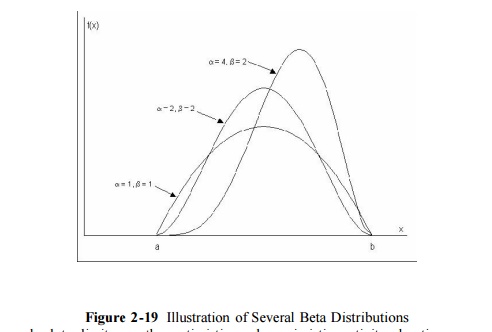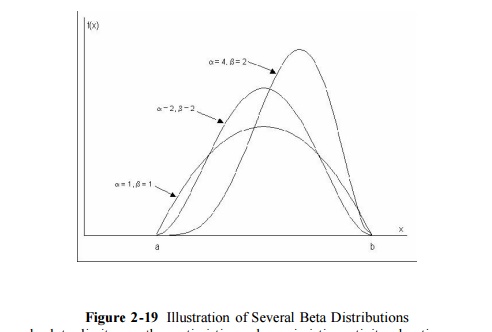Chapter: Civil : Construction Planning And Scheduling
Scheduling with Uncertain Durations

Scheduling
with Uncertain Durations
Previously described the application of critical
path scheduling for the situation in which activity durations are fixed and
known. Unfortunately, activity durations are estimates of the actual time required,
and there is liable to be a significant amount of uncertainty associated with
the actual durations. During the preliminary planning stages for a project, the
uncertainty in activity durations is particularly large since the scope and
obstacles to the project are still undefined. Activities that are outside of
the control of the owner are likely to be more uncertain. For example, the time
required to gain regulatory approval for projects may vary tremendously. Other
external events such as adverse weather, trench collapses, or labor strikes
make duration estimates particularly uncertain.
Two simple approaches to dealing with the
uncertainty in activity durations warrant some discussion before introducing
more formal scheduling procedures to deal with uncertainty. First, the
uncertainty in activity durations may simply be ignored and scheduling done
using the expected or most likely time duration for each activity. Since only
one duration estimate needs to be made for each activity, this approach reduces
the required work in setting up the original schedule. Formal methods of
introducing uncertainty into the scheduling process require more work and
assumptions. While this simple approach might be defended, it has two
drawbacks. First, the use of expected activity durations typically results in
overly optimistic schedules for completion; a numerical example of this
optimism appears below. Second, the use of single activity durations often
produces a rigid, inflexible mindset on the part of schedulers. As field
managers appreciate, activity durations vary considerable and can be influenced
by good leadership and close attention. As a result, field managers may loose
confidence in the realism of a schedule based upon fixed activity durations.
Clearly, the use of fixed activity durations in setting up a schedule makes a
continual process of monitoring and updating the schedule in light of actual
experience imperative. Otherwise, the project schedule is rapidly outdated.
A second simple approach to incorporation uncertainty also
deserves mention. Many managers recognize that the use of expected durations
may result in overly optimistic schedules, so they include a contingency
allowance in their estimate of activity durations. For example, an activity
with an expected duration of two days might be scheduled for a period of 2.2
days, including a ten percent contingency. Systematic application of this
contingency would result in a ten percent increase in the expected time to
complete the project. While the use of this rule-of-thumb or heuristic
contingency factor can result in more accurate schedules, it is likely that
formal scheduling methods that incorporate uncertainty more formally are useful
as a means of obtaining greater accuracy or in understanding the effects of
activity delays.
The most
common formal approach to incorporate uncertainty in the scheduling process is
to apply the critical path scheduling process (as described in Section 2.3) and
then analyze the results from a probabilistic perspective. This process is
usually referred to as the PERT scheduling or evaluation method. As noted
earlier, the duration of the critical path represents the minimum time required
to complete the project. Using expected activity durations and critical path
scheduling, a critical path of activities can be identified. This critical path
is then used to analyze the duration of the project incorporating the
uncertainty of the activity durations along the critical path. The expected
project duration is equal to the sum of the expected durations of the
activities along the critical path. Assuming that activity durations are
independent random variables, the variance or variation in the duration of this
critical path is calculated as the sum of the variances along the critical
path. With the mean and variance of the identified critical path known, the
distribution of activity durations can also be computed.

Since
absolute limits on the optimistic and pessimistic activity durations are
extremely difficult to estimate from historical data, a common practice is to
use the ninety-fifth percentile of activity durations for these points. Thus,
the optimistic time would be such that there is only a one in twenty (five
percent) chance that the actual duration would be less than the estimated
optimistic time. Similarly, the pessimistic time is chosen so that there is
only a five percent chance of exceeding this duration. Thus, there is a ninety
percent chance of having the actual duration of an activity fall between the
optimistic and pessimistic duration time estimates. With the use of
ninety-fifth percentile values for the optimistic and pessimistic activity
duration, the calculation of the expected duration according to Eq. (2.1) is
unchanged but the formula for calculating the activity variance becomes:

The difference between Eqs. (11.2) and (11.5) comes only in
the value of the divisor, with 36 used for absolute limits and 10 used for
ninety-five percentile limits. This difference might be expected since the
difference between bi,j and ai,j would be larger for
absolute limits than for the ninety-fifth
percentile
limits.
While the PERT method has been made widely
available, it suffers from three major problems. First, the procedure focuses
upon a single critical path, when many paths might become critical due to
random fluctuations. For example, suppose that the critical path with longest
expected time happened to be completed early. Unfortunately, this does not
necessarily mean that the project is completed early since another path or
sequence of activities might take longer. Similarly, a longer than expected
duration for an activity not on the critical path might result in that activity
suddenly becoming critical. As a result of the focus on only a single path, the
PERT method typically underestimates the actual project duration.
As a second problem with the PERT procedure, it is
incorrect to assume that most construction activity durations are independent
random variables. In practice, durations are correlated with one another. For
example, if problems are encountered in the delivery of concrete for a project,
this problem is likely to influence the expected duration of numerous
activities involving concrete pours on a project. Positive correlations of this
type between activity durations imply that the PERT method underestimates the
variance of the critical path and thereby produces over-optimistic expectations
of the probability of meeting a particular project completion deadline.
Finally, the PERT method requires three duration
estimates for each activity rather than the single estimate developed for
critical path scheduling. Thus, the difficulty and labor of estimating activity
characteristics is multiplied threefold.
As an alternative to the PERT procedure, a
straightforward method of obtaining information about the distribution of
project completion times (as well as other schedule information) is through the
use of Monte Carlo simulation. This technique calculates sets of artificial
(but realistic) activity duration times and then applies a deterministic
scheduling procedure to each set of durations. Numerous calculations are
required in this process since simulated activity durations must be calculated
and the scheduling procedure applied many times. For realistic project
networks, 40 to 1,000 separate sets of activity durations might be used in a
single scheduling simulation. The calculations associated with Monte Carlo
simulation are described in the following section.
A number of different indicators of the project schedule can
be estimated from the results of a Monte Carlo simulation:
z Estimates of the expected time
and variance of the project completion.
z An estimate of the distribution of completion
times, so that the probability of meeting a particular completion date can be
estimated.
z The probability that a particular activity will
lie on the critical path. This is of interest since the longest or critical
path through the network may change as activity durations change.
The disadvantage of Monte Carlo simulation results from the additional
information about activity durations that is required and the computational
effort involved in numerous scheduling applications for each set of simulated
durations. For each activity, the distribution of possible durations as well as
the parameters of this distribution must be specified. For example, durations
might be assumed or estimated to be uniformly distributed between a lower and
upper value. In addition, correlations between activity durations should be
specified. For example, if two activities involve assembling forms in different
locations and at different times for a project, then the time required for each
activity is likely to be closely related. If the forms pose some problems, then
assembling them on both occasions might take longer than expected. This is an
example of a positive correlation in activity times. In application, such
correlations are commonly ignored, leading to errors in results. As a final
problem and discouragement, easy to use software systems for Monte Carlo
simulation of project schedules are not generally available. This is
particularly the case when correlations between activity durations are desired.
Another approach to the simulation of different
activity durations is to develop specific scenarios of events and determine the
effect on the overall project schedule. This is a type of "what-if"
problem solving in which a manager simulates events that might occur and sees
the result. For example, the effects of different weather patterns on activity
durations could be estimated and the resulting schedules for the different
weather patterns compared. One method of obtaining information about the range
of possible schedules is to apply the scheduling procedure using all
optimistic, all most likely, and then all pessimistic activity durations. The
result is three
project
schedules representing a range of possible outcomes. This process of
"what-if" analysis is similar to that undertaken during the process
of construction planning or during analysis of project crashing.
Related Topics